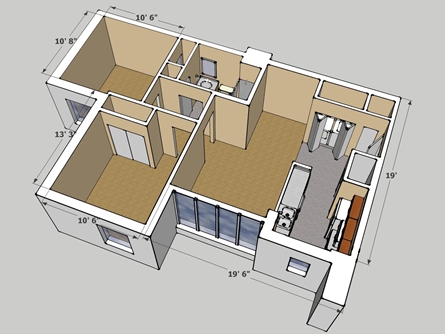How is Super Built-Up (SBU) area calculated while buying a flat?
If you are searching a flat / apartment to buy, you will come across some terminology regarding the flat area size. There is lot of calculations to make you understand the flat size. Finally you get puzzled and don’t get the actual size. Now, this article shows you the actual picture of the calculations, so you do not have to believe somebody blindly.
Developer / Agencies use these terminologies to make you understand the flat size –
-
Super Built-Up Area
-
Covered Area
-
Carpet Area
Firstly you as a buyer should understand how the wrong interpretation / misinformation are given by the developers or any individual. You may come across this mostly when you deal with small local builder / local brokers who actually do not know the calculations or may want to hide the full information.
The question a buyer asks is “What is the size of the flat?” And the answer is the super built up size i.e. let say 1000 sq. ft. Next, if a buyer asks what is the actual size of the flat after reducing the Super Built Up? The answer mostly is 25% less than the SBU size. Here is the first misinformation provided to a buyer. There is no as such rule that it should be always 25% lesser of the SBU size. Some people say it is 30% or 20%, but they do not let you know the actual calculation. In most cases, they do not know the calculations. After reading this article, you can make your own calculations.
A brief idea about the terminologies and calculations –
Carpet Area – Total area of the floor only without internal walls. It is a self explanatory terminology i.e. how much carpeting you can do. You can get it from the floor plan provided by the developer or you may measure physically.
Covered Area – Covered area is the total area of the flat only i.e. wall to wall measurement. It includes the carpet area and the internal walls. This can be calculated by adding up 12-15% of the carpet area. If the wall is very thick, you may consider upper band i.e. 15%. Covered area sometimes called as Built Up area.
Super Built-up Area – Now this is the most confusing calculation. The total common area of the building / project is calculated here. It includes lobby, staircase, lifts, shafts, security rooms, conference room, other amenities like swimming pool, indoor games room etc. Keep in mind, the total common area where everybody has access is considered to calculate Super Built Up. It is simple. The total area is divided by total units of the building or the project and proportionately added to the flat size. Now you can understand that all the projects are not same; so all the projects can’t be same percentage calculations. You may get the actual calculation from developer that how proportionately the SBU is calculated.

Illustration-
We now calculate the SBU of a flat assuming carpet area is 1000 sq. ft.
Carpet area = 1000 sq. ft.
Covered Area = Carpet area + 15% of Carpet area
= 1000 sq. ft. + 15% of 1000
= (1000 + 150) sq. ft.
= 1150 sq. ft.
Super Built-Up area = Covered Area + Proportionate common area
Let us assume that the total common area is 3200 sq. ft. and there are 8 flats of same size in the building. So, 3200 sq. ft. will be divided by 8
Proportionate common area = 3200/8 sq. ft.
= 400 sq. ft.
So, the SBU of the flat is = (1150 + 400) sq. ft.
= 1550 sq. ft.
It is clear now that the SBU will be less in a standalone building, whereas, the SBU will be more in a complex.
Our advice is to concentrate on the carpet area of the flat. The actual size what you are getting. You can now easily understand the terminology and the calculations. So, next time make your own calculations.
Note, SBU is not used in everywhere. Sometime Covered area is mentioned to denote flat size. So, if somewhere the flat size is given as covered area 1000 sq. ft. and you are comparing with other super built up 1000 sq. ft. flat, you are actually calculating wrong. Ask what size is given to you whether it is Carpet/Covered/SBU area.
Please share with others if you like this article and find this as helpful to everyone.
Written by: Arnab Ray

Join our list
Subscribe to our mailing list and get interesting stuff and updates to your email inbox.

16 comments
Arthur Smith
Thank you very much for that most informative and clear explanation of the super built-up area. It is very helpful indeed given all the confusing illogical explanations I have heard.
Regards
Arthur
Debabrata Chakraborty
My Flat size is 730 Sq. Ft. Super Built up area. If it is to be considered the super built up percentage is 20% then How it will be calculated? I want to illustrate it to get the covered area of my Flat in the following two methods, please send me the answer that wcih process is the correct one?
Mode of Calculatio -1
730 / 120 X 100 = 608 Sq. Ft.(approx)
Mode of Calculation-2
80% of 730 = 730 X 0.80 = 584 Sq. Ft.
PLEASE SEND ME YOUR REPLY
Arnab Ray
Thanks for sharing your query. I understand your confusion. This happens with many people. This is very nice point everyone should understand. We would be happy to help you. As you mentioned, your flat size has 20% SBU and the size of your flat is 730 sq. ft. No one asks, whether the SBU percentage to add with covered area or subtract from total area. You calculated in both way. So different result is coming.
Here, let me take subtract from total area. To make it simple, 20% of 730 is 146. So you may subtract 146 from 730. The result will be 584 sq. ft. In this regards, the second calculation is right.
Now let me explain, how the first calculation made you confused. Here, if you add 20% to 584, that will result to 700 and not 730. There you are going wrong in the first calculation. You are back calculating and making it 608 and adding 20% to that. It is 20% when subtracting SBU percentage from total area and 25% when adding SBU percentage to covered area.
In your case, you may measure once to understand which one is your exact covered area. You may also ask your developer, whether to add or subtract the SBU. I hope I tried to make you understand. If you like it, please share to all.
Purnendu mitra
Most helpful illustration. Can a builder/developer legally supress facts and deliver carpet area about 36% less than offered SBU area in any case? Pl clarify and help.
Arnab Ray
Thank you for your query. I would surely try to help you.
In any case, no one is supposed to suppress any facts legally or illegally. That is where a proper guidance and advise is important from a professional real estate consultant. If the builder has already mentioned a percentage for SBU calculation, then there is no question of suppression. If it is not mentioned, then you may take it as offence.
Now a days, every professional developers mention exact SBU, Covered and Carpet area. After RERA imposition, it will be a rule to mention exact SBU, Built up and Carpet area.
ARUP BISWAS
FOR A STAND ALONE BUILDING,
THE EASIEST WAY OF CALCUATION :
SUPER BUILT UP AREA – ITS 17%
=COVERED AREA
OR
COVERED AREA + ITS 20%
= SUPER BUILT UP AREA
AND
CARPET AREA + ITS 12 % = COVERED AREA
ARUP BISWAS
SUPER BUILT UP AREA = COVERED AREA + UNDIVIDED PROPORTIONATE SHARE OF COMMON AREA / AMENITIES / FACILITIES/PRIVILEGES/ EASEMENTS.
MORE THE COMMON AMENITIES MEANS MORE THE SUPER BUILT UP AREA.
SUPER BUILT UP AREA IS MORE IN A HOUSING COMPLEX THAN IN A STAND ALONE BUILDING.
IF THE WALLS I ARE VERY THICK , COVERED AREA = CARPET AREA + IT’S 15%.
IF THE WALLS ARE VERY THIN ,COVERED AREA = CARPET AREA + IT’S 12%.
WHERE THERE ARE A LOT OF COMMON AMENITIES, LIKE COMMON SWIMING POOL,
COMMON CONFERENCE HALL, COMMON SECURITY ROOM, COMMONPLAY GROUND ALONG WITH OTHER VERY COMMON AMENITIES/ AREAS, MAY BE SUPER BUILT UP AREA – IT’S 36% = CARPET AREA. OTHERWISE IT’S NOT ECONOMICAL
ARUP BISWAS
CARPET AREA = AREA WITHIN WALLS.
CARPET AREA = AREA WITHOUT INTERNAL WALLS.
COVERED AREA = BUILT UP AREA = AREA UNDER ROOFS OF THE BUILDING.
SUPER BUILT UP AREA = COVERED AREA + ALL COMMON AREAS OF THE PREMISES INCLUDING COMMON AMENITIES LIKE LIFTS, BALCONIES, STAIRCASES, SECURITY ROOMS, COMMON PASSAGES, COMMON PIPELINES, COMMON CAR PARKING AREAS ETC.
Arnab Ray
Thank you for your valuable input.
P. K. Sen
In my case the builder mentioned in the drawing ” Super Built up area as 991sq ft. not mentioned the SUB % he has considered. Now I have calculated the carpet area adding all the wall to wall internal distances which comes as 767.14sq ft and 61.08sq.ft for balcony. We have got common parking area and builder informed us that they have not considered garage/parking area while calculating the Super Built Area. Now my question is how much sq ft we should mention during registration of the flat. because if we register with 991sq ft during sailing of the flat we can not charge for the common garage to our future buyer. What is the way out.
Arnab Ray
Sir, thanks for your query. Well, as you said you calculated the built up area, you yourself can calculate the SBU percentage. You can ask the builder to mention carpet or built up area in the deed when registering. However, the price will be calculated according to 991 sft. Secondly, garage area can never be included to SBU. The builder is right. But, if you are purchasing a car parking space, it should be mentioned in the deed along with demarcation. So, when you sell the property, every thing will be mentioned in your deed. The salable area, Built up area/carpet area, car parking number. There will be no problem in future if you sell the property with these details in the deed.
hi sir this raghu i want Villa Corpet area
Land Area=1200
Buildep area=845
Corpet Area=? How to calculate?
Arnab Ray
Hi Mr. Raghu, thanks for your query. Carpet area does not depends on your land area. You can deduct 10% from built up area to get an approximate carpet area. You may also measure physically to get the carpet area. If built up area is 845 sq. ft. you can get approximately 760 sq. ft.
ASHOK BANERJEE
what is common area of the G+4 flat
Arnab Ray
Thank you for your query. Common area in a G+4 standalone building would be common passage, lift, staircase, liftroom, caretaker/security room, lift lobby, rooftop.
S. Sarbadhikari
Thanks for a good explanation of the subject. My query is, builders normally charge for garage space on the ground floor or basement. Is this area then not included for purpose of Super Built up calculations? Or is this space then double charged sometimes as SBU and also as garage space.